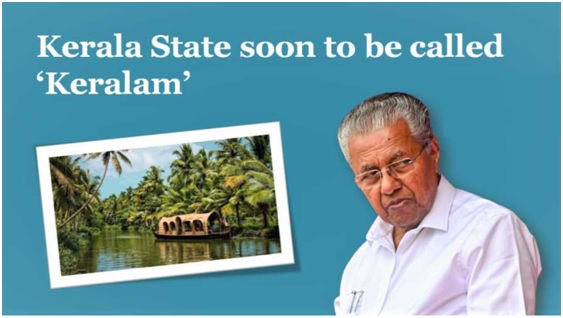Resolution to Rename State as 'Keralam' Approved by Kerala Assembly (Indian Express)

- 10 Aug 2023
Why in the News?
A resolution adopted by the Kerala Assembly calls upon the Central government to officially change the state's name to 'Keralam' in the Constitution and all official records.
What is the essence of the resolution?
- The Kerala Assembly unanimously passed a resolution urging the Central government to officially change the name of the State from Kerala to Keralam.
- The resolution highlights the linguistic aspect of our state's name, which is "Keralam" in Malayalam.
- It underscores the historical significance of the formation of states based on language on November 1, 1956, a day also commemorated as Kerala's establishment day.
- Throughout the freedom struggle and subsequent periods, there has been a fervent call for a united Kerala that embraces all Malayalam-speaking communities.
- This sentiment has resonated strongly.
- However, a discrepancy exists between the name of our state, as commonly used, and its representation in the first Schedule of the Constitution, where it is listed as "Kerala."
- With unanimous consensus, this Assembly is making an earnest appeal to the Union Government. Under the provisions of Article 3 of the Constitution, it is requested that swift actions be taken to effectuate the change in the state's name to "Keralam."
The Origins of the Names of Kerala:
Kerala's Origin
- The etymology of the name 'Kerala' has given rise to various theories.
- The earliest historical inscription that mentions Kerala dates back to Emperor Ashoka's Rock Edict II from 257 BC.
- This inscription makes reference to the local ruler as Keralaputra, signifying "son of Kerala," and also as "son of Chera," denoting the Chera dynasty.
The Origins of Keralam
- In relation to 'Keralam,' scholars postulate that it might have its roots in the term 'Cheram.'
- Experts have noted the resemblance between the word 'keram' and the Canarese (Kannada) rendition of cheram.
- They have interpreted 'Keralam' as 'Cheram,' representing the expanse between Gokarnam and Kanyakumari.
- The term's possible origin could be traced to the root 'cher,' implying a sense of connection or joining.
- This connotation becomes evident in the compound term 'Cheralam,' where 'alam' signifies region or land.
Quest for the Contemporary State:
- Throughout history, the population conversing in Malayalam found themselves under the dominion of diverse monarchs and princely domains within the vicinity.
- The 1920s marked a significant turning point with the emergence of the Aikya Kerala (Unified Kerala) movement, propelling the discourse for an independent state designated for the Malayalam-speaking populace.
- Central to its mission was the amalgamation of Malabar, Kochi, and Travancore into a singular territorial entity.
The state of Kerala after Independence:
- The progression of Kerala post-Independence witnessed a pivotal transformation through the amalgamation and integration of princely realms.
- An instrumental stride in the configuration of the modern Kerala state was the confluence of various princely states, culminating in a new identity.
- The inaugural step in this direction occurred on July 1, 1949, as the territories of Travancore and Kochi were harmonized, giving rise to the entity known as the Travancore-Cochin State.
- Subsequently, as the movement for linguistic-based state reorganization gained momentum, the State Reorganisation Commission of the Union Government played a crucial role. Their recommendations paved the way for the creation of the Kerala state.
- Guided by Syed Fazl Ali, the Commission advocated the incorporation of the Malabar district and the Kasargod taluk into the state predominantly inhabited by Malayalam speakers.
- The culmination of these efforts culminated in the formal establishment of the state of Kerala on November 1, 1956.
- In Malayalam, this state found its appellation as "Keralam," while in English, it retained the name "Kerala."
The Process to Rename any State:
Constitutional Provision:
- The power to alter a state's name lies with the Parliament.
- Article 3 of the Constitution of India confers the authority upon the Parliament to modify the name, area, or boundaries of a state.
Proposal Initiation:
- The renaming process can be initiated either by the Parliament or the state assembly.
- The state assembly sends a proposal to the Central government in the form of a resolution.
- For presenting the bill in Parliament, a recommendation from the President is essential.
Procedure:
- In cases where the proposed change affects multiple states, the legislature of the impacted state must receive the bill.
- Originally absent in the Constitution, the provision to forward the bill to the state legislature was introduced via the 5th Amendment Act of 1955.
- The State Legislative Assembly has a designated period to offer its opinions on the bill.
- While the suggestions of the State Legislature hold no enforceable power against the President or Parliament, they are a part of the deliberation process.
- Parliament has the authority to disregard the state legislature's opinion.
- After receiving the state legislative assembly's suggestions or when the stipulated timeframe lapses, the bill returns to Parliament for further deliberations.
Passing of the Bill:
- The bill is sent to the President for approval.
- Once the President grants approval, the bill transforms into law, effectuating the modification of the state's name.
Additional Institutions Involved:
- The process involves securing No Objection Certificates (NOCs) from various bodies such as the Ministry of Railways, Intelligence Bureau, Department of Posts, Survey of India, and Registrar General of India.
- Upon receiving NOCs from these agencies, the Union Ministry of Home Affairs (MHA) endorses the state's resolution.
- This comprehensive procedure underscores the intricate steps and institutions entailed in the process of renaming a state, all governed by constitutional provisions and regulatory mechanisms.
Mains Question:
- Elaborate on the constitutional provisions and intricate procedural steps entailed in the process of renaming a state in India. Discuss the roles played by the Parliament, state legislature, and other pertinent institutions in this multifaceted process. (15M)
